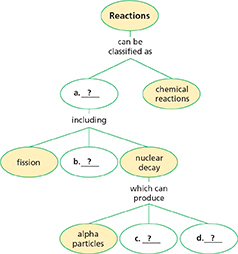CHAPTER 10 Study Guide
10.1 Radioactivity
 Key Concepts
Key Concepts
During nuclear decay, atoms of one element can change into atoms of a different element altogether.
Common types of nuclear radiation include alpha particles, beta particles, and gamma rays.
Nuclear radiation can ionize atoms.
Devices that are used to detect nuclear radiation include Geiger counters and film badges.
Vocabulary
radioactivity, p. 292; radioisotope, p. 292;
nuclear radiation, p. 293; alpha particle, p. 293;
beta particle, p. 294; gamma ray, p. 294;
background radiation, p. 296
10.2 Rates of Nuclear Decay
 Key Concepts
Key Concepts
Unlike chemical reaction rates, which vary with the conditions of a reaction, nuclear decay rates are constant.
In radiocarbon dating, the age of an object is determined by comparing the object's carbon-14 levels with carbon-14 levels in the atmosphere.
Vocabulary
half-life, p. 299
10.3 Artificial Transmutation
 Key Concepts
Key Concepts
• Scientists can perform artificial transmutations by bombarding atomic nuclei with high-energy particles such as protons, neutrons, or alpha particles.
• Scientists can synthesize a transuranium element by the artificial transmutation of a lighter element.
Vocabulary
transmutation, p. 303; transuranium elements, p. 304; quark, p. 305
10.4 Fission and Fusion
 Key Concepts
Key Concepts
Over very short distances, the strong nuclear force is much greater than the electric forces among protons.
In nuclear fission, tremendous amounts of energy can be produced from very small amounts of mass.
Vocabulary
strong nuclear force, p. 308; fission, p. 309;
chain reaction, p. 311; critical mass, p. 311; fusion, p. 315; plasma, p. 315





